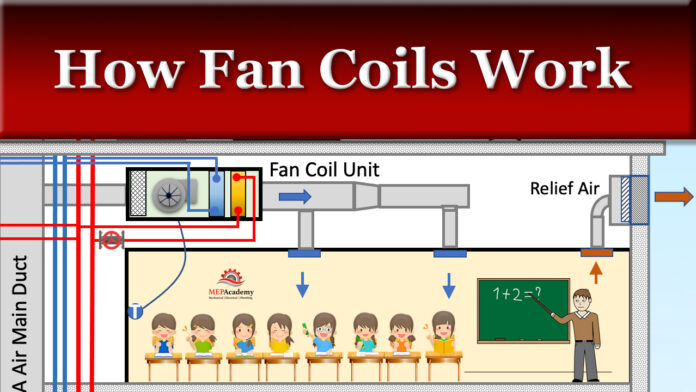How Fan Coils Work in HVAC Systems. In this article you’ll learn what a Fan Coil Unit (FCU) is, and where they’re mostly used in the commercial HVAC industry. We’ll cover the different types of fan coils, including 2-pipe, 4-pipe, horizontal and vertical.
If you prefer to watch the YouTube version of this presentation than scroll to the bottom for the video.
Fan Coil Components
Fan coils are very simple compared to other pieces of equipment. The fan coil contains a filter, fan, coil, and a drain pan to catch condensate from the cooling coil. The source of the heating and cooling is usually provided by a Chiller and Boiler located in a mechanical room, or outside on the roof.
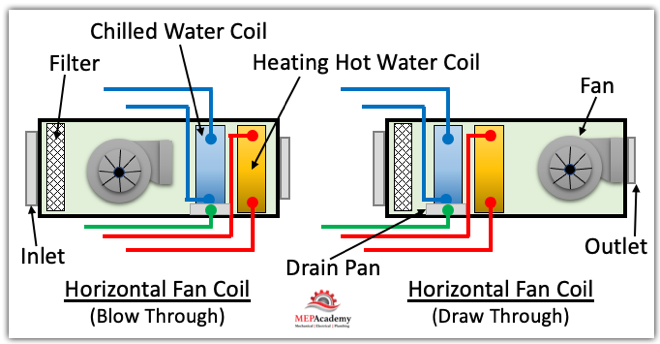
Air enters the back of the fan coil and passes over filters before passing over the heating and cooling coils. The fan can be arranged in either a blow-through or draw-through configuration. With a blow through, the fan is before the coils, in a draw-through, the fan is after the coils.
The filters provide a means of keeping the air free of dust and particles, while preventing the coils from becoming clogged. The filter can be in a filter track attached at the back of the fan coil or a separate return air filter grill could be provided in the ceiling such as is common in some hotel room style installations using horizontal fan coils.
Depending on the size of the fan coil, there could be anywhere from one to three fans or more within the housing. These fans can be provided with ECM motors which make them energy efficient.
The fan coil will contain either one or two coils, depending on the design. There could be a heating and cooling coil installed, or just one coil for either heating or cooling. We are only discussing water-based fan coils, so refrigerant based DX coils are discussed in another article.
The cooling coil will require a drain pan to catch the water dripping off the coil. This is moisture that has been removed from the air and has condensed on the cold coil, much like you see condensate form on the outside of a glass of ice water. Its required to have drainpipe from this drain pan to an approved waste receptor, like a floor sink or the tailpipe of a sink.
How Vertical Fan Coils Work
Just like the vertical stacked Heat Pumps used in hotels, there are also Vertical Stacked Fan Coils. These vertically stacked fan coils can be either a two-pipe or four-pipe system. Using a 4-pipe system, there will be a chilled water and heating hot water supply and return piping, and of course a fifth pipe for condensate.

These vertical fan coils come with riser piping attached for easily stacking them one on top the other from floor to floor. These are best used in high-rise building such as hotels, condominiums, apartments, dormitories or similar high-rises.
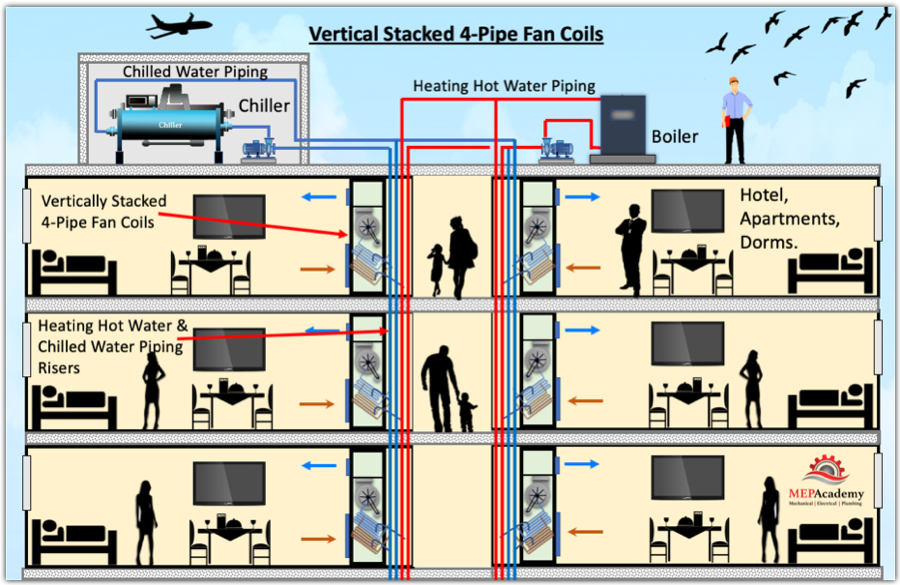
Vertical fan coils are usually available from 3/4 ton to 4 Tons, or from 300 CFM to 1,600 CFM. The Chilled water entering temperature could range from 42F to 48F, with heating hot water entering temperatures of 120F to 180F. The units weight anywhere from 200 to 300 pounds.
How Horizontal Fan Coils Work in HVAC Systems
These Fan Coils use Chilled water or Heating Hot Water to provide the room with cooling or heating. A central ventilation unit will provide tempered air through a main duct to all the fan coils. This is the primary air supplied to the inlet of the fan coil to provide the required ventilation air (outside air) in accordance with ASHRAE 62.1. The fan coils reduce the amount of ductwork needed by the central system, because most of the heat transfer is done using water instead of air, by using Chilled Water or Heating Hot Water.
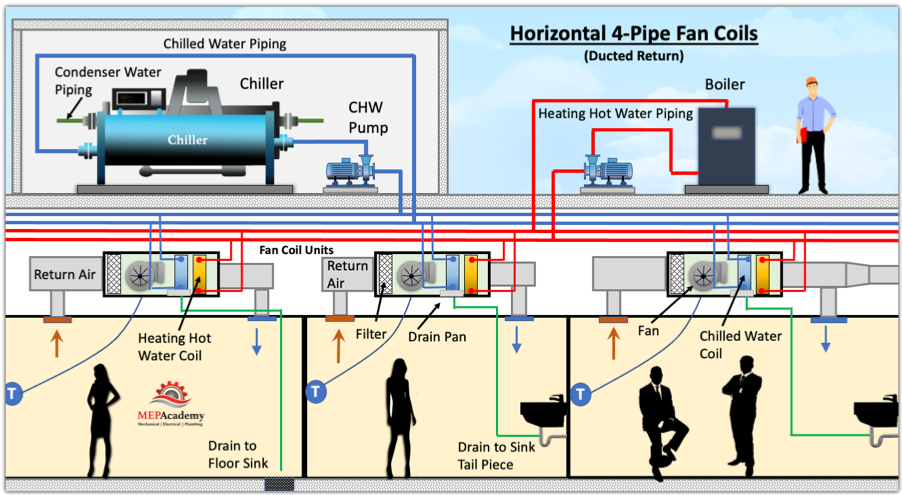
In the above image is a ducted return system where the supply air recirculates back into the fan coil. Some method of providing ventilation air will be required to meet code, which we’ll show shortly.
Fan coils provide both sensible and latent cooling, along with heating at the zone level, while the central ventilation unit conditions the outside air that feeds all zone fan coils.
Since the coils are very small in fan coil units, they’re not suited to handle large quantities of latent heat often brought in by ventilation or outside air. In these cases the use of a dedicated outside air system (DOAS) is recommended.
Fan coils can be either ducted or non-ducted and can be horizontal or vertical in configuration, and can be exposed or concealed.
Fan Coil Units with Dedicated Outside Air Systems (DOAS)
The benefit of using a DOAS is that the latent and sensible heat of the ventilation air can be handled by the Dedicated Outside Air System, while the fan coil will handle the load of the room it serves. This outdoor air can be decoupled from the fan coil units allowing any zones fan coil to be running at slow speed or be switched off when not in use, while still receiving ventilation air. Decoupled ventilation air means that the air from the outdoor air system is fed directly to the room without entering the fan coil unit, its totally independent of the FCU.
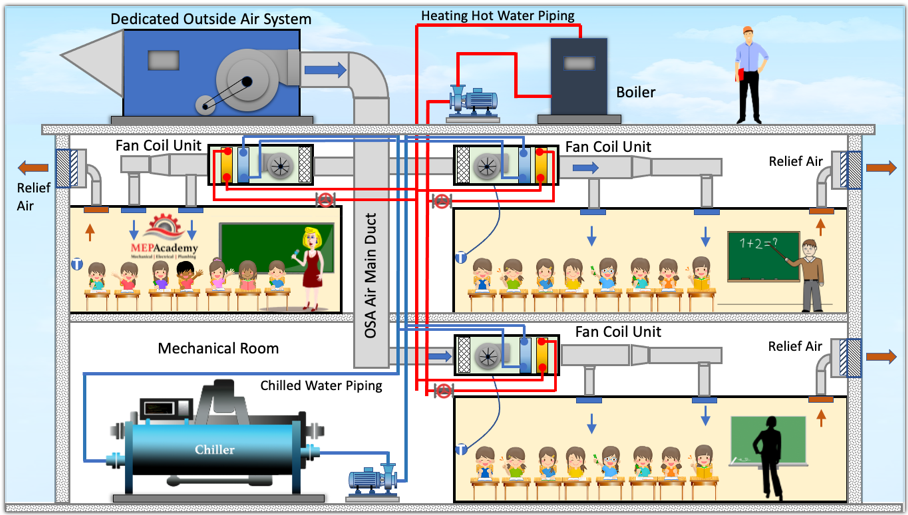
Fan coils are limited on their coil, fan and filter capacities. If the project requires additional heating or cooling capacity, then the use of a Blower Coil will provide the same benefits as a fan coil but with increased capacity. Blower coils come in larger CFM sizes, and higher static pressures, with coils that are larger and can provide additional heating or cooling capacity. These larger blower coils provide room for thicker filters, making for better filtration.
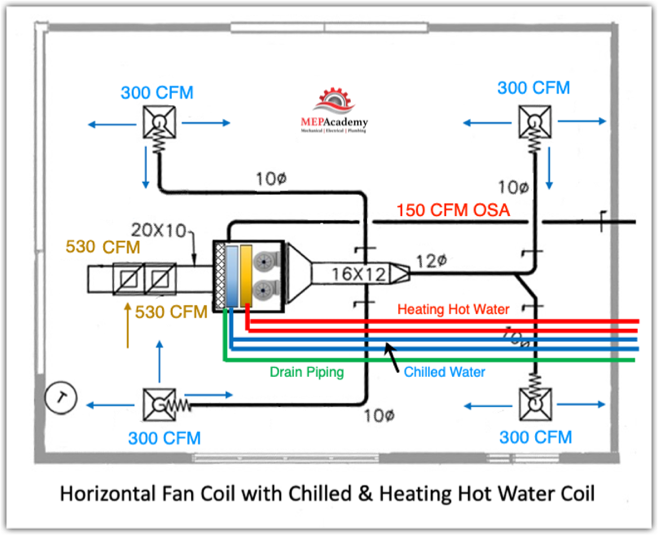
Hope you enjoyed How Fan Coils Work in HVAC Systems, if you prefer to watch the video, see YouTube video below.


